Ijraset Journal For Research in Applied Science and Engineering Technology
- Home / Ijraset
- On This Page
- Abstract
- Introduction
- Conclusion
- References
- Copyright
Structural Analysis and Optimization of Washing Machine Spider, Drum and Shaft
Authors: Siddhesh Kohale, Shardul Situt, Mihir Solankurkar, Nilay Sole, Harshit Srivastav, Kartik Sulla, Kartik Sulla
DOI Link: https://doi.org/10.22214/ijraset.2024.61443
Certificate: View Certificate
Abstract
This project\'s thesis centers on identifying diverse loading scenarios and leveraging their outcomes to optimize two components of a washing machine. The initial phase of this report involves generating a numerical model of a washing machine. This encompasses assembling it in a mechanical software program (ANSYS) and defining specific boundary conditions and material properties for the problem. Decisions on simulation parameters, such as mesh size, types of elements, and the number of iterations in the calculations, will also be made. An examination of various loading scenarios is conducted to gain an overall understanding of the problem and select four specific cases for application in reconstructing the target parts (Spider and front cover). This examination involves calculating the worst relative angle between the Spider and the resultant force for two opposing loads inside the drum. The resulting angle is found to be 35º between the arm and the direction of the resultant force. By applying these diverse loading conditions to the model, the mechanical behavior of the parts will be determined, and this information will be utilized in the reconstruction. Mechanical behavior, in this context, refers to understanding the maximum levels of stress (tension, compression, and shear) and deformation (displacement and strain). Once the critical points of stress in the Spider and front cover are identified, various new shapes are created. The reconstruction parameters considered include volume reduction, stress level reduction, and deformation. Two of these shapes are selected and tested in the numerical model as a validation process.
Introduction
I. INTRODUCTION
Washing machines have become ubiquitous in homes worldwide, revolutionizing the once laborious and cumbersome task of cleaning clothes. These appliances operate by rotating clothes within a cylinder, combining them with water and cleansing agents. The efficiency of this process relies on the mechanical intricacies of the cylinder and the Spider responsible for transmitting rotational forces to it. Considering that wet clothes can exert substantial reaction forces on the rotating cylinder, it becomes crucial to precisely and safely calculate the mechanical properties of both the cylinder and the supporting Spider. This bachelor project is dedicated to determining the critical load and optimal position where reaction forces on these components reach their maximum, thereby preventing malfunctions in operational washing machines. The exploration also delves into the possibility of devising new configurations for the Spider and front cover, aiming to achieve a more even distribution of reaction forces and minimize the risk of part damage.The main objective with this project is to perform a research on the loading cases applied to a washing machine and to optimize the Spider and the front cover.
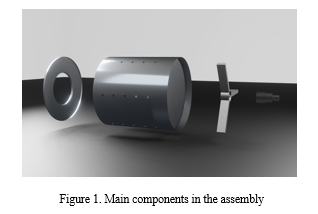
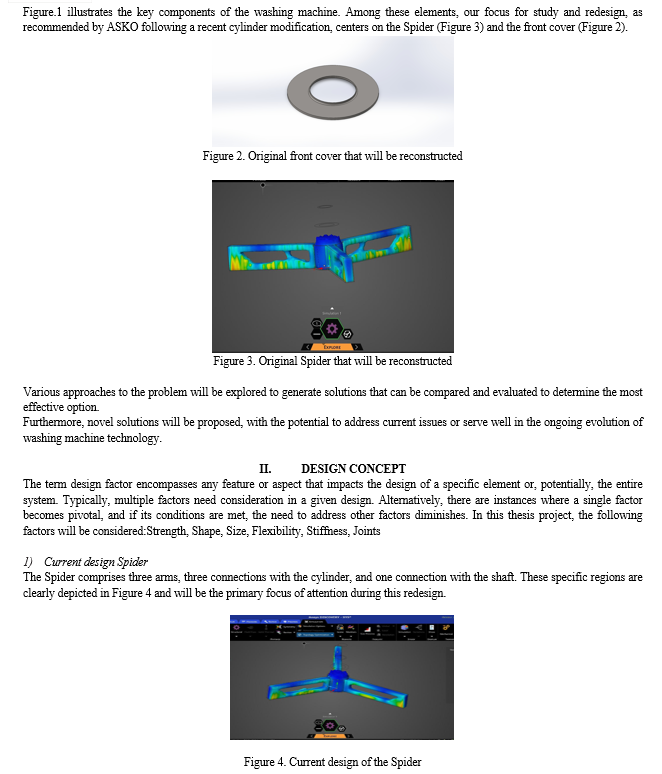
These regions exhibit distinct characteristics, geometries, and functions. The connection with the shaft is represented by a sturdy cylinder featuring stiffeners to maintain its relative position with the rest of the component. The arm's primary characteristic is its cross-sectional profile, a critical consideration as its selection depends on the stresses arising under the working conditions explained earlier. Concerning the connections with the cylinder, they possess two key features. The first pertains to the surface in contact with the cylinder, while the second involves the mass where the screw will be positioned.
- Material And Manufacturing Process
The material chosen for producing this part is aluminum, and its properties are outlined in the materials chapter. Despite being lighter than steel, the consideration of manufacturing and production costs, coupled with the stress levels in this component, prompts the exploration of alternative materials such as steel or plastics.
The manufacturing process for aluminum involves die-casting, which necessitates a substantial production volume to achieve favorable cost efficiencies. In die-casting, molten metal is injected at high pressure and velocity into a split metal die, with aluminum being melted in a "cold-chamber." The key advantages of this process include high production rates and precision in both smooth surfaces and details. However, a drawback lies in the complexity and expense of the die, leading to a preference for cheaper dies that require surface finishing through tooling. Die casting becomes economically viable when the production quantity falls within the range of 5,000 to 10,000 pieces, making it the most cost-effective option for large quantities of parts.
2) Front Cover
In front-loaded washing machines, the cylinder is horizontally arranged, open from one of its bases, which connects to the door. This open base, referred to as the front cover, is constructed with a sizable hole to facilitate the entry and exit of laundry into the washer. The design of this component is specifically a metal ring that connects its outer edge to the cylinder through bending, with the inner edge left free (refer to the shape in Figure 5). This design facilitates the closure of the container with the door and rubber. The rubber, positioned between the external drum ```````````````````````````````````````````````and the door, allows the drum to move freely without any clothes escaping.
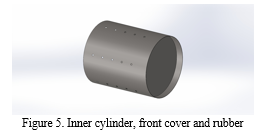
The redesign primarily focuses on enhancing the current situation by reducing stress and minimizing displacement on the piece. Additionally, considerations are given to the volume or size of the component with the aim of reducing the amount of material used in manufacturing, resulting in economic savings—a crucial aspect in any comprehensive study.
- Material and Manufacturing Process
The design of a manufactured part relies significantly on the chosen material and manufacturing process. For instance, the design approach for an aluminum die-cast part differs considerably from that of a steel sheet metal part, even though both serve identical functions.
The front cover, specified in the material's chapter, is crafted from stainless steel 18:9 (consisting of 18% chromium and 9% nickel), showcasing its unique properties.
Stainless steel encompasses various types tailored to desired characteristics. Its resistance to corrosion, minimal maintenance requirements, and familiar appearance make it an ideal material for diverse applications.
In applications where both steel properties and corrosion resistance are vital, stainless steel takes precedence. Its distinction from carbon steel lies in the chromium content. Unprotected carbon steel readily corrodes when exposed to air and moisture, with the formed iron oxide film accelerating further corrosion. In contrast, stainless steels contain sufficient chromium to establish a passive chromium oxide film, hindering surface corrosion and preventing its spread into the internal structure.
Upon exposure to oxygen, chromium forms a thin, invisible passivation layer of chromium oxide, preserving the metal's luster, impervious to water and air. This layer rapidly reforms when scratched, a phenomenon known as passivation, also observed in metals like aluminum and titanium, contingent on a high chromium proportion.
Additionally, stainless steel is entirely recyclable. On average, a stainless steel object comprises approximately 60% recycled material, with 40% originating from end-of-life products and 60% from manufacturing processes [12].
Due to its myriad benefits, stainless steel finds application in washing machine cylinders, offering resistance to water, soaps, and detergents. Its smooth surface prevents damage to clothes during the washing process, avoiding abrasions and cuts caused by irregular surfaces. Moreover, it protects against potential damage to zips, coins, buttons, keys, and similar objects at high machine speeds, a risk in cylinders made of coated materials.
Despite these advantages, the next chapter will explore the potential of transitioning to a different material with superior properties, enhanced results, or cost-effectiveness.
III. METHODOLOGY
1) Interaction
Effective interaction plays a pivotal role in the accurate design of the simulation, as the functionality of all components is defined by their interactions, ultimately influencing the quality of the outcome. In this context, all connections are treated as "tie" constraints. The Spider, for instance, is connected to the cylinder through three constraints.
Specifically, the front cover is affixed using a single tie constraint, mimicking the folded edge, establishing a connection between the cylinder and the front cover. This approach ensures a cohesive and realistic simulation of their interaction.
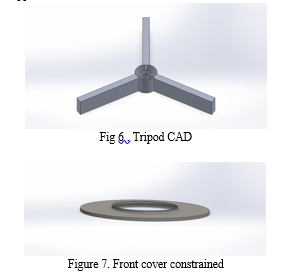
The loading process is treated as static, even though the cylinder undergoes rotation. This assumption is based on the consideration that the applied loads remain constant over time, both in magnitude and direction.
The chosen boundary conditions emulate a double-pinned axle. In this configuration, the model is constrained from translation and rotation in all directions, as depicted in Figure 8. This restriction ensures a stabilized and controlled analysis of the system.
2) Loading cases
This section aims to establish a series of loading cases that accurately represent the operational conditions of a washing machine. While acknowledging that some scenarios may be impractical in a real washing machine, the results derived from these cases contribute to a comprehensive understanding of the washing machine's behavior.
This analysis transcends numerical considerations, emphasizing a holistic understanding of the washing process as it relates to the real-world object. The applied loads are numerically representative of wet clothes pressed against the cylinder wall, positioned randomly in their natural state.
In each simulation, the rotational speed remains consistently at its maximum. However, the duration varies contingent on the load balance within the cylinder. Specifically, the rotational speed is set at 1735 rpm for 90 seconds when the cylinder is evenly loaded, and it is adjusted to 1690 rpm for 60 seconds in the case of an unbalanced cylinder. This approach ensures a comprehensive exploration of the interplay between rotational dynamics and load distribution, reflecting real-world washing machine conditions.
3) Load
An additional pivotal factor influencing the calculation of stresses within the cylinder is the applied load.
Loads in Each Simulation:
Two primary loads are considered in each simulation:
Centrifugal Force Load:
This load arises from the centrifugal force exerted when the cylinder is in rotation.Clothes and Water Mass Load:
This load is determined by the mass of clothes and water as they rotate within the cylinder. The calculation for this load is expressed by the following equation:
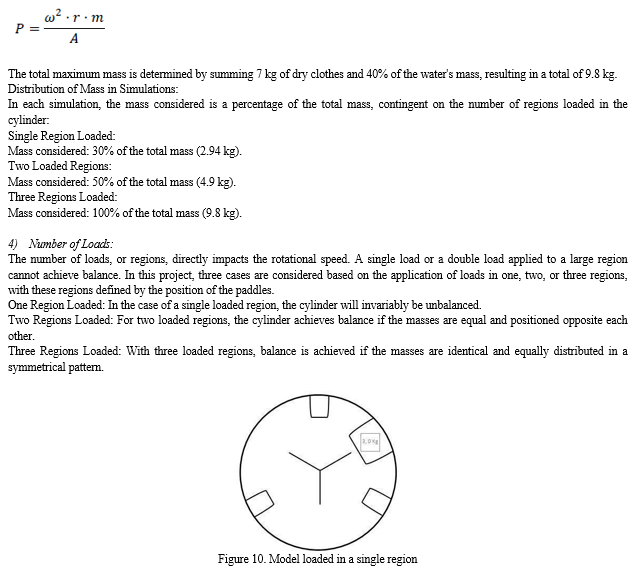
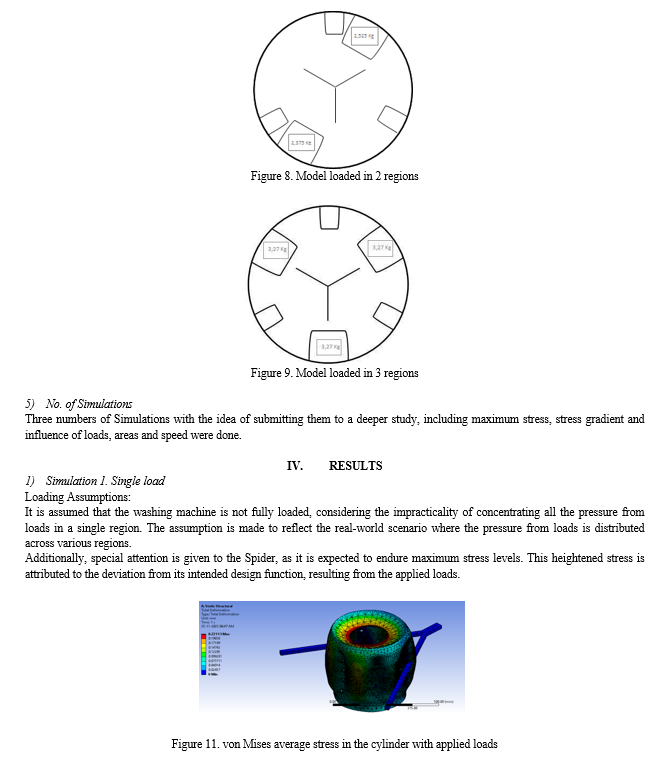
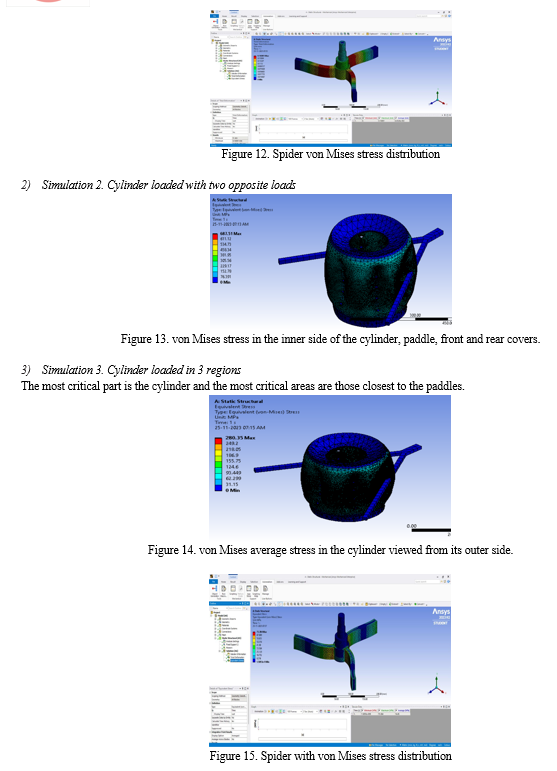
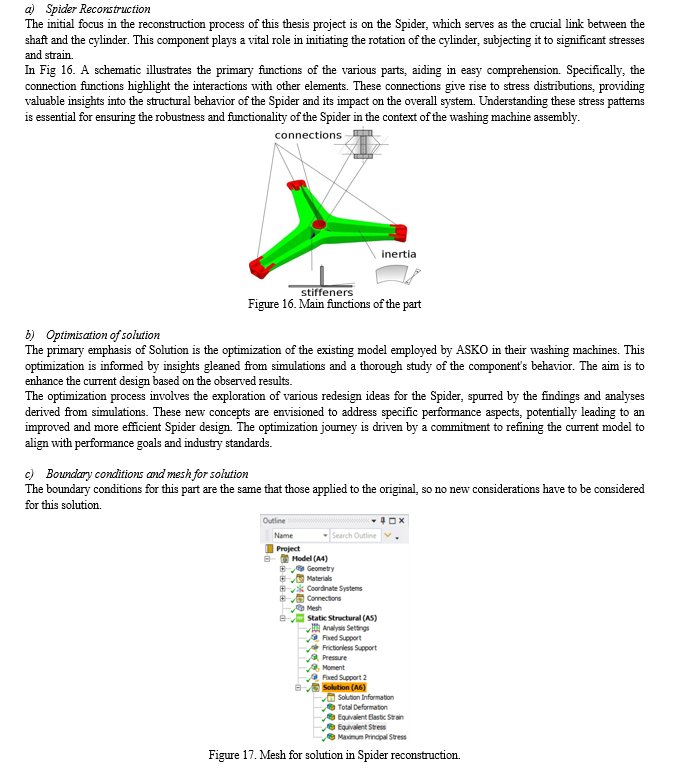
d) Boundary conditions and mesh for solution 1
The boundary conditions for this part are the same that those applied to the original, so no new considerations have to be considered for this solution.
Conclusion
The Project undertook a detailed examination of the mechanical elements within a washing machine, focusing particularly on the front cover and tripod components. Utilizing Abaqus for a comprehensive analysis, the project aimed to refine the topology of these parts to enhance performance, cost-efficiency, and structural integrity. The optimization strategies employed in revamping the tripod and front cover led to significant enhancements across various metrics. For the tripod, Solution 1 demonstrated notable success by reducing displacement, stress, and material volume. The careful assessment of stress distribution and displacement, independent of singularities, revealed a strategic approach to bolstering the component\'s structural performance. Solution 2 for the tripod introduced an innovative design by switching to steel material and integrating functions with the rear cover. An economic analysis based on steel prices highlighted potential cost savings, underlining the project\'s focus on practical considerations. Both Solution 1 and Solution 2 exhibited decreased displacement compared to the existing model, validating the effectiveness of the modified profile sections. Stress distribution analysis using von Mises criteria showcased significant improvements, with Solution 1 surpassing Solution 2 and the current model in stress reduction and safety factors. Volume comparison between different models emphasized the economic advantages of optimization, particularly with Solution 1 showing an 18.6% reduction in volume, indicating reduced material usage and associated costs. To sum up, the project not only optimized critical washing machine components but also demonstrated tangible improvements in displacement, stress distribution, and material efficiency. These results underscore the feasibility and benefits of the proposed redesigns, offering valuable insights for the washing machine industry in terms of performance and cost-effectiveness. The meticulous optimization approach, complemented by thorough numerical validation, positions this project as a significant contribution to the field of washing machine design and manufacturing.
References
[1] www.asko.com [2] www.engineeringtoolbox.com [3] http://people.fh-landshut.de/~maurer/numeth/node145.html [4] G. BRALLA, JAMES. Design for Manufacturability handbook. Second Edition. [5] G. ULLMAN, DAVID. The Mechanical Design Process. Second Edition. [6] OSSWALD & MENGES. Materials Science of Polymers for Engineers [7] http://abduh137.wordpress.com/category/material-selection/ (April,2011) [8] BENHAM, P.P., CRAWFORD, R.J. & ARMSTRONG, C.G. (1987). Mechanics of Engineering Materials, 1996. (Second edition) Prentice Hall. [9] Raj, S. & Choney, Tenzin & Rao, Lokavarapu. (2022). Structural Integrity Analysis of a Washing Machine Tripod (Front Load) and Redesign Using Taguchi Method. 10.1007/978-981-19-4208-2_35. [10] López, Raimundo & Molina, Pablo & Zuheros, Rocío. (2011). STRUCTURAL ANALYSIS OF A WASHING MACHINE THROUGH ITS LOADING CASES : REDESIGN OF THE TRIPOD AND THE FRONT COVER. [11] https://www.mech4study.com/strength-of-material/theory-of-failure-considerd-for-machine-design.html/ [12] https://efficientengineer.com/mohrs-circle/ [13] Wrona, Stanislaw. (2022). Performance Analysis of Active Structural Acoustic Control Applied to a Washing Machine. Sensors (Basel, Switzerland). 22. 10.3390/s22197357. [14] Eromonsele, Daniel & Arubayi, Ofome. (2023). DESIGN AND FABRICATION OF A PEDAL POWERED WASHING MACHINE. [15] Mendoza-Flores, Shair & Velázquez-Villegas, Fernando & Cuenca-Jiménez, Francisco. (2024). Optimization of a Horizontal Washing Machine Suspension System: Studying a 7 DOF Dynamic Model Using a Genetic Algorithm Through a Bounding Box Fitness Function. Journal of Vibration Engineering & Technologies. 10.1007/s42417-024-01288-1. [16] Sun, Hao. (2022). Vibration Analysis and Control of the Suspension System of the Drum Washing Machine by Applying SMA. Journal of Physics: Conference Series. 2200. 012009. 10.1088/1742-6596/2200/1/012009.
Copyright
Copyright © 2024 Siddhesh Kohale, Shardul Situt, Mihir Solankurkar, Nilay Sole, Harshit Srivastav, Kartik Sulla, Kartik Sulla. This is an open access article distributed under the Creative Commons Attribution License, which permits unrestricted use, distribution, and reproduction in any medium, provided the original work is properly cited.

Download Paper
Paper Id : IJRASET61443
Publish Date : 2024-05-01
ISSN : 2321-9653
Publisher Name : IJRASET
DOI Link : Click Here
 Submit Paper Online
Submit Paper Online

